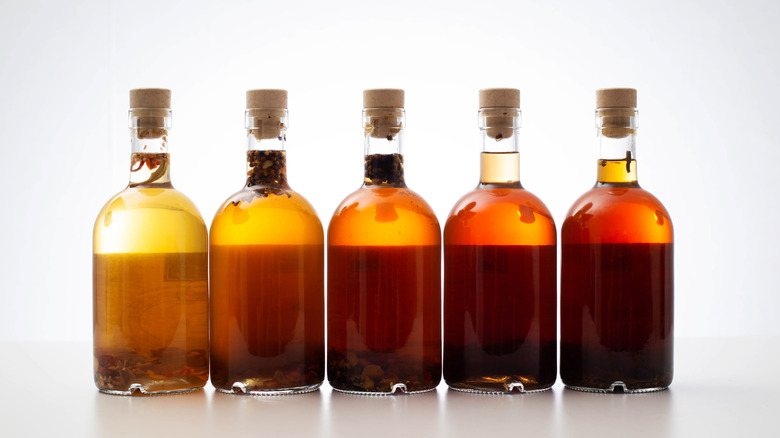8 Of The Worst Botulism Outbreaks In US History
Botulism is considered to be quite rare in the United States.You tend to hear more about E.coli outbreaks or food poisoning spells than this food borne illness. But, there was a time before now-commonplace food regulations when improper food safety measures led to many sickness and death. These major outbreaks, although tragic, allowed for major changes in policies which are still helpful today. Due to human error, botulism outbreaks still occur today, and they can be incredibly dangerous.
Botulism is a serious illness caused by a toxin that attacks the body's nerves, leading to breathing difficulties, muscle paralysis, and in some instances, death. Botulism cases can be treated, but the recovery period can be prolonged and extensive.
There are five major types of botulism, with food borne botulism, being one. Foodborne botulism, caused by the consumption of food contaminated with botulinum toxin, often occurs due to improper preparation or storage of home-canned, preserved, or fermented goods. It can't be smelled, tasted, or seen. The bacteria can thrive in anaerobic environments, and conditions with low salt, sugar, or acid. As the bacteria grows, it releases toxins into contaminated food.
The worst botulism outbreaks in U.S. history tend to be isolated, with moderate numbers of people affected per outbreak. It may be someone consuming the food they made themselves, or sharing it with family or a friend. On occasion, larger outbreaks have occurred from restaurants or within supply chains. They can be devastating, as they often are for unsuspecting consumers.
1919 - Canned olive outbreak
By the 19th century, industrialization of American food was well underway as canned products were produced in masses to feed soldiers during the Civil War. Canning picked up steam among the general public in the early 20th century, with the advent of the double-seam process that is still used in modern canning today. However, some consumers were weary, as the risk of improperly canned food products is severe. In the past, if a can had dents or seemed swollen, it was a telltale sign of spoilage, but not all spoilage cases were easily detectable. Botulism is caused by bacteria that invisible to the naked eye.
From late 1919 into early 1920, multiple deadly botulism outbreaks occurred, affecting people in Ohio, Michigan, and New York. The deaths of 18 individuals were caused by the consumption of canned olives, which were a popular appetizer in the 1920s. The contaminated olives crossed multiple states and were traced back to packaging facilities in California. Press coverage of the outbreaks stoked fear among the general public, who were just getting used to canned food products.
As a result, the canning and olive industries took action, creating a botulism commission where scientists and experts worked to develop safety regulations to mitigate future outbreaks. These practices, namely sterilization procedures, were overseen by the California State Board of Health, establishing a working relationship between government officials, suppliers, and scientists. The alignment of these entities for the sake of public health set a precedent for other food companies. Food products like canned fish and canned vegetables, later followed suit.
1977 - Hot sauce outbreak
Between March 31 and April 6, 1977, unsuspecting customers at a popular Mexican restaurant in Pontiac, Michigan, fell victim to one of the largest botulism outbreaks in U.S. history. The restaurant called Trini & Carmen's was located in a suburb of Detriot, and had been frequented since 1966. By the early 1970s, the restaurant was known as one of the best places in the Metro-Detriot area to find authentic Mexican cuisine. Many of Trini & Carmen's food items were made in-house, like tamales and hot sauce. The hot sauce in particular was made with home-canned jalapeño peppers, and featured on a variety of menu items.
Between March 31 and April 6, 1977, reports of type B botulism began popping up in the area. The total reached 59 affected individuals, all of whom had eaten at Trini & Carmen's. It was then discovered that each ill individual had consumed the restaurant's homemade hot sauce either on its own or included in another dish. Many consumers were hospitalized, including a 23-year-old surgical nurse who worked at the hospital just down the street. The nurse, a woman named Sally Koskey, filed a class-action damage suit against the restaurant following her hospitalization.
This case was covered nationally, with the New York Times calling it the "nation's worst outbreak of botulism." Trini and Carmen's restaurant closed down temporarily within days, and the contaminated jalapeño pepper jars were taken. The restaurant persevered following the incident and remains open to this day.
1978 - Salad bar outbreak
Clovis, a small city near the eastern border of New Mexico prides itself on many things. However, amongst the tourist attractions and illustrious cultural history is an incident in food safety that remains one of the worst in U.S. history. One Friday night in April of 1978, a banquet was held at the Colonial Park Country Club in Clovis. Afterward, 34 people fell ill with type A botulism, and two deaths followed.
As patrons fell ill, with varying degrees of severity, volunteers from the area aided the state in tracking down and informing hundreds of guests who had been to the Colonial Park Country Club that week. Anti-toxin for botulism was shipped to Clovis from around the country. It was known that food from the banquet caused the botulism outbreaks, so food samples were sent to a lab and tested. In a press conference, it was stated that potato salad and a commercially prepared ingredient served at the country club's salad bar were the culprits. It was also rumored that a commercially prepared three-bean salad caused the botulism outbreaks, with some victims suing the company that produced them.
Since the majority of botulism cases affect small groups, researchers took this rare opportunity to gather more information regarding the recovery of patients with type A botulism. Researchers interviewed 27 patients months after the initial illness. The results showed that many symptoms persisted for months following the botulism outbreak. Shortness of breath, exercise intolerance, and general weakness persisted from nine to 13 months for some patients.
1983 - Sautéed onion outbreak
While today's youth might not seen them the same way, in the 1980s, malls were all the rage. A place for people to gather and socialize, get all of their shopping done, and grab a meal too. One such place, the Northwoods Mall in Peoria, Illinois, had a popular restaurant called the Skewer Inn. The Skewer Inn was popular for salads and gyros but served a variety of other dinner items as well.
In October 1983, dozens of customers dined at the Skewer Inn. However, tragedy struck when 28 of those diners tested positive for type A botulism, resulting in hospitalizations and one death. The common factor with these patients? Each had decided to order a patty-melt sandwich. Over a three-day period, any who ordered the patty-melt sandwich from Skewer Inn unknowingly consumed sautéed onions contaminated with the botulinal toxin.
Patients from the Peoria outbreak have spoken out in recent years about the aftermath of the illness, with many claiming it caused life-changing effects. One patient experienced exacerbating symptoms following the day of consumption. The patient recounted waking up with a headache and later in the day having trouble breathing. The following morning, their vision was blurry, and days later they had difficulty walking properly.
At the hospital, paralysis set in that took over a year to recover from, with residual symptoms like light sensitivity or difficulty swallowing still affecting them. Some patients lost their ability to communicate during the recovery process. Others experienced lasting nerve pain and muscle weakness, even decades after the onset of the outbreak. The mental and economic toll of long-term hospitalization and medical bills, along with the physical impacts, followed families throughout the rest of their lives.
1994 - Baked potato outbreak
Diners at a restaurant in El Paso, Texas fell victim to one of largest botulism outbreaks in United States history. It happened at a restaurant called Tassos Greek Cuisine and Seafood Restaurant, which served many Greek-style dishes, including a variety of dips. On April 8 or 9, 1994 two of the dips on the menu, unbeknownst to staff or patrons, contained a toxin produced by Clostridium botulinum.
One dip, called skordalia, was made using mashed potatoes and flavored with ingredients like garlic and lemon. The other dip was an eggplant-based dip that was also contaminated. The toxin found in the dips formed on aluminum foil-wrapped baked potatoes that were kept at room temperature for multiple days prior to being used in the dips. Although botulism is common in canned goods, it can also develop due to improper food handling practices. And in many cases, baking doesn't destroy botulism spores. Clostridium botulinum, a bacterium found in soil and on the skin of raw potatoes, was present and identified as what caused sickness for Tassos' patrons.
Due to improperly stored ingredients, 30 diners fell ill with botulism symptoms. At the onset of the illness, some patients arrived at the hospital with shortness of breath, blurred vision, double vision, and weakness. These are all common symptoms of botulism and often appear 18 to 36 hours after exposure. Four of those affected needed mechanical ventilation.
2015 - Canned potato outbreak
Church potlucks are often causes for celebration. On April 19, 2015, one which took place at the Cross Pointe Free Will Baptist Church in Lancaster, Ohio didn't end up much fun for some of the 60-plus guests who attended and consumed potluck dishes.
Within days, the Fairfield Medical Center started reporting patients with botulism symptoms to the Ohio Department of Health. Following the report about the first patient, others began arriving at the center with similar symptoms. A 55-year-old woman died and 29 people fell ill. The illnesses were traced back to a potato salad prepared by an attendee of the potluck. The potato salad used home-canned potatoes, which were made using a boiling water canner.
Water canning can only be implemented when processing high-acidic food like pickled beets or apples, because high-acid foods prevent the growth of the bacterium that causes botulism. Clostridium botulinum can't be killed by boiling. Low-acidic foods like potatoes, do not prevent the growth of that bacterium. Along with the use of a boiling water canner, the potatoes were not heated after being removed from the can for the potato salad. This is a step that could have inactivated the toxin prior to the dish being served at the potluck. For canning low-acid foods like potatoes, the use of a pressure canner, which heats foods to 240 to 250 degrees Fahrenheit or higher, would have killed the spores that produce the bacterium that causes botulism.
2016 - Prison wine outbreak
In June of 2016, a Mississippi prison clinic filled up with inmates exhibiting similar symptoms. Patients exhibited muscle weakness, movement issues, and shortness of breath. There were 31 patients in total that appeared showing signs of illness, with 20 exhibiting severe botulism symptoms. Many were hospitalized, with some requiring intubation.
Staff members from the federal prison in Mississippi assumed the illnesses were caused by an alcoholic beverage made by prisoners often called "pruno," "hooch," or "prison wine". Inmates aren't allowed to consume alcohol, but by using ingredients that can be accessible inside of a prison, like sugar, water, bread, and fruit, an alcoholic beverage can be made.
The bread acts as a yeast component, and the mixture is warmed and then left for days to ferment. The yeast and sugar interact, with the yeast converting the sugars into ethanol and carbon dioxide over time. The resulting beverage can contain anywhere from two to fourteen percent alcohol by volume, but it can be dangerous to consume. There is no way of telling the exact alcohol percentage per batch, and a bacterium like Clostridium botulinum can develop.
In the case of the Mississippi prison outbreak, a prisoner stated that some of the prison wine circulating at the time was made using potatoes, tomato paste, apples, and honey. The tomato paste was said to have been from a bulging can, which is a sign of spoilage. However, it is unknown what batch or ingredients specifically caused the outbreak.
2017 - Nacho cheese outbreak
When stopping for gas or going for a bathroom break during a long car ride, sometimes grabbing a quick snack at the gas station seems like a good move, and for a handful of people in Walnut Grove, California, they did just that. Unfortunately, the rumors of gas station food gone wrong hit home for over 10 people who attended the Valley Oak Food and Fuel gas station from April to May 2017.
Customers of the gas station consumed nacho cheese from a dispenser at the station. Some opted for tortilla chips and cheese, others pumped some cheese into prepackaged chip bags to spice up their snack. Within a week following their snack times, 10 people fell ill, with one patient ultimately dying. The patient was in the hospital for weeks on a ventilator before falling into a coma. Officers impounded the nachos and cheese sauce from the station, which was temporarily closed. When the gas station reopened, it was only able to sell prepackaged food items.
The cheese sauce in the dispenser at Valley Oak Food and Fuel gas station was meant to be consumed within five days and kept at a temperature of 140 degrees Fahrenheit. However, upon inspection, it was found that not only was the cheese kept at 111 degrees Fahrenheit, but there was oil separation, and the cheese was in the dispenser for approximately 30 days past its expiration date. Due to the improper storage of the nacho cheese sauce, it became the source of the largest botulism outbreak to have occurred in California to date.








